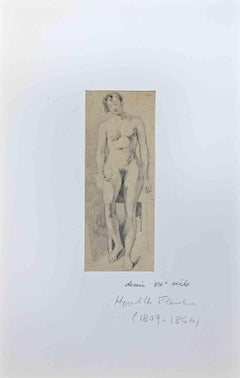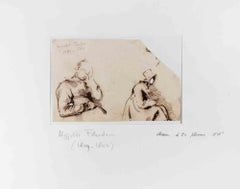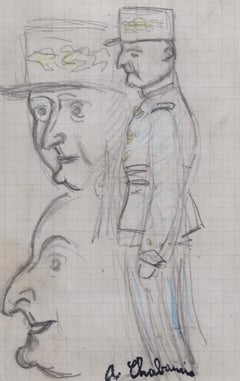Jean-Hyppolyte Flandrin Drawings and Watercolor Paintings
to
1
3
2
1
3
Overall Height
to
Overall Width
to
3
3
3
2
2
1
1
2
1
3
807
412
288
228
2
1
Artist: Jean-Hyppolyte Flandrin
Nude of Woman- Original Drawing by Jean-Hyppolyte Flandrin - Mid-19th century
By Jean-Hyppolyte Flandrin
Located in Roma, IT
Nude of Woman is an Original Pencil Drawing realized by Jean-Hyppolyte Flandrin.
The little artwork is in good condition on a yellowed paper.
Signature by pencil on the back of the drawing, included a white cardboard passpartout (33.2x21 cm).
Jean-Hippolyte Flandrin (23 March 1809 – 21 March 1864) was a 19th-century French painter. His celebrated 1836 work Jeune Homme Nu...
Category
Mid-19th Century Modern Jean-Hyppolyte Flandrin Drawings and Watercolor Paintings
Materials
Pencil
Nude of Woman- Original Drawing by Jean-Hyppolyte Flandrin - Mid-19th century
By Jean-Hyppolyte Flandrin
Located in Roma, IT
Nude of Woman is an Original Pencil Drawing realized by Jean-Hyppolyte Flandrin.
The little artwork is in good condition on a yellowed paper.
Signature by pencil on the back of the drawing, included a white cardboard passpartout (34x21.5 cm).
Jean-Hippolyte Flandrin (23 March 1809 – 21 March 1864) was a 19th-century French painter. His celebrated 1836 work Jeune Homme Nu...
Category
Mid-19th Century Modern Jean-Hyppolyte Flandrin Drawings and Watercolor Paintings
Materials
Ink
Two Figures - Original Drawing by Jean-Hyppolyte Flandrin - 19th Century
By Jean-Hyppolyte Flandrin
Located in Roma, IT
Two Figures is an Original China Ink Drawing realized by Jean-Hyppolyte Flandrin.
The little artwork has a missing corner.
Signature by pencil, included a white cardboard passpartout (35x51 cm).
Jean-Hippolyte Flandrin (23 March 1809 – 21 March 1864) was a 19th-century French painter. His celebrated 1836 work Jeune Homme Nu...
Category
Mid-20th Century Modern Jean-Hyppolyte Flandrin Drawings and Watercolor Paintings
Materials
Ink
Related Items
Male Torso
By John Koch
Located in London, GB
Pencil, coloured pencil and chalk on paper, titled (lower left), signed (lower right), 31cm x 46cm, (51cm x 68cm framed).
John Koch was an American painter and teacher, and an impo...
Category
1950s American Modern Jean-Hyppolyte Flandrin Drawings and Watercolor Paintings
Materials
Paper, Chalk, Pencil, Color Pencil
Mon Colonel
By Auguste Chabaud
Located in London, GB
'Mon Colonel', pencil and crayon on paper, by noted French artist, Auguste Chabaud (circa 1914-1918). A delightfully simple drawing of a French Army colonel in profile along with clo...
Category
1910s Modern Jean-Hyppolyte Flandrin Drawings and Watercolor Paintings
Materials
Paper, Crayon, Pencil
Alfred Bendiner, (Baseball Hitter and Pitcher -- The Philadelphia Phillies?)
By Alfred Bendiner
Located in New York, NY
Of course it's possible that these baseball players aren't from a Philadelphia team, but I doubt it. There was so much drama and intrigue with both the Philadelphia Phillies and the ...
Category
Mid-20th Century American Modern Jean-Hyppolyte Flandrin Drawings and Watercolor Paintings
Materials
India Ink, Watercolor
"Manhattan Bridge" NYC American Scene Modernism Watercolor WPA Urban Realism
By Reginald Marsh
Located in New York, NY
Reginald Marsh "Manhattan Bridge" NYC American Scene Modernism Watercolor WPA Urban Realism, 20 x 14 inches. Watercolor and pencil on paper, 1938. Signed...
Category
1930s American Modern Jean-Hyppolyte Flandrin Drawings and Watercolor Paintings
Materials
Paper, Watercolor, Pencil
Portrait Drawing of a Man at a Desk in India Ink on Tan Paper
Located in Soquel, CA
Portrait Drawing of a Man at a Desk in India Ink on Tan Paper
Figurative drawing of a man at a desk by Jerry O'Day (American, 1912). The man is seated, about to pick up a pen. His features are somewhat exaggerated, showing foreshortening in the arms and legs. This piece is executed with confident strokes but nonetheless feels loose and playful.
Signed in the bottom right corner, "Jerry O'Day."
Mat size: 20"H x 16"W
Paper size: 12"H x 8"W
Image window size: 11.25"H x 7.25"W
Jerry O'Day is also known as Geraldine Heib. Born in Oakland, California, on June 17, 1912. Geraldine Heib assumed the name Jerry O'Day at an early age. She grew up in Washington and studied in Seattle at the Cornish School of Fine Arts. Upon moving to the San Francisco Bay area in 1938, she further studied with Bufano as a muralist for two years. O'Day wed sculptor David Lemon and had a gallery in a converted cod fishery in Belvedere from 1942 until 1963. At that time, the couple moved to a houseboat in Sausalito, where she remained until her demise on March 30, 1986.
Post War California artist, Jerry O'Day studied at the Cornish School of Fine Arts in Seattle; studied with Beniamino Bufano for two years. She lived in the artist's colony at the Cod fishery with artist David Lemon on Belvedere Island in the San Francisco Bay Area from 1942 - 1963.
Solo Exhibitions: City of Paris, Rotunda Gallery; Lucien Labaudt Gallery, 1963; Torrance Gallery, San Anselmo, 1955; Marin Art Gallery, Sausalito, 1956; Palace of The Legion of Honor, San Francisco, 1962; East & West Gallery, Fillmore Street, San Francisco; Landmarks Gallery, Marin County, 1991.
Selected Group Exhibitions: 65th Annual Painting and Sculpture Exhibition of the San Francisco Art Association at the San Francisco Museum of Art, 1945; Fourth Winter Invitational, California Palace of The Legion of Honor, San Francisco, 1963.
Source:
David J Carlson...
Category
Mid-20th Century American Modern Jean-Hyppolyte Flandrin Drawings and Watercolor Paintings
Materials
India Ink, Paper
H 20 in W 16 in D 0.25 in
The Parade of Fairground Wrestlers, Modern French School
Located in London, GB
'The Parade of Fairground Wrestlers', India ink on art paper, Modern French School (early 1900s). Traveling shows often held promotional events before opening in local areas to generate enthusiasm for the spectacle. This is an intriguing depiction of the various acts on stage strutting their stuff before an audience of potential customers. On the platform, fairground wrestlers mix with clowns, dancers, a percussionist in bolero hat...
Category
Early 20th Century Modern Jean-Hyppolyte Flandrin Drawings and Watercolor Paintings
Materials
Paper, India Ink
Nude woman lying
By Tom Leveritt
Located in New Orleans, LA
A pencil drawing with ink wash
Tom Leveritt (1976) was raised in Texas, sent to boarding school in the UK, got a first at Cambridge, an Army Scholarship i...
Category
2010s Modern Jean-Hyppolyte Flandrin Drawings and Watercolor Paintings
Materials
Pencil, Ink
Lounge Chair Nap - Vintage Illustration in Ink and Watercolor
By Irene Pattinson
Located in Soquel, CA
Lounge Chair Nap - Vintage Illustration in Ink and Watercolor
A man lazes in a lounge chair, book still in hand, as he dozes off with a content e...
Category
1950s American Modern Jean-Hyppolyte Flandrin Drawings and Watercolor Paintings
Materials
India Ink, Pen, Paper
H 12 in W 9 in D 0.25 in
Boston Abstract Expressionist Hyman Bloom Original Pencil Drawing Martin Sumers
By Hyman Bloom
Located in Surfside, FL
This is a unique artwork. This is an original Hyman Bloom drawing of fellow artist and his very good friend Martin Sumers.I believe this was drawn at the “variations of a theme” at Sumers gallery in NYC. The last two photos show a poster and a card from their shows. it is not included in this listing, it is just for provenance.
Provenance: Acquired from the Sumers estate collection.
Hyman Bloom (March 29, 1913 – August 26, 2009) was a Latvian-born American painter. His work was influenced by his Jewish heritage and Eastern religions as well as by artists including Altdorfer, Grünewald, Caravaggio, Rembrandt, Blake, Bresdin, James Ensor and Chaim Soutine. He first came to prominence when his work was included in the 1942 Museum of Modern Art exhibition "Americans 1942 -- 18 Artists from 9 States". MoMA purchased 2 paintings from the exhibition and Time magazine singled him out as a "striking discovery" in their exhibition review.
His work was selected for both the 1948 and 1950 Venice Biennale exhibitions and his 1954 retrospective traveled from Boston's Institute of Contemporary Art to the Albright Gallery and the de Young Museum before closing out at The Whitney Museum of American Art in 1955. In a 1954 interview with Yale art professor Bernard Chaet, Willem de Kooning indicated that he and Jackson Pollock both considered Bloom to be “America’s first abstract expressionist”, a label that Bloom would disavow. Starting in the mid 1950s his work began to shift more towards works on paper and he exclusively focused on drawing throughout the 1960s, returning to painting in 1971. He continued both drawing and painting until his death in 2009 at the age of 9
Hyman Bloom (né Melamed) was born into an orthodox Jewish family in the tiny Jewish village of Brunavišķi in what is now Latvia, then part of the Russian Empire
At a young age Bloom planned to become a rabbi, but his family could not find a suitable teacher. In the eighth grade he received a scholarship to a program for gifted high school students at the Museum of Fine Arts. He attended the Boston High School of Commerce, which was near the museum. He also took art classes at the West End Community Center, a settlement house. The classes were taught by Harold Zimmerman, a student at the School of the Museum of Fine Arts, who also taught the young Jack Levine at another settlement house in Roxbury. When Bloom was fifteen, he and Levine began studying with a well-known Harvard art professor, Denman Ross, who rented a studio for the purpose and paid the boys a weekly stipend to enable them to continue their studies rather than take jobs to support their families.
He took Bloom and Levine on a field trip to the Museum of Modern Art in New York, where Bloom was impressed by the work of Rouault and Soutine and began experimenting with their expressive painting styles.
In the 1930s Bloom worked sporadically for the Public Works of Art Project and the Federal Art Project (WPA), He shared a studio in the South End with Levine and another artist, Betty Chase. It was during this period that he developed a lifelong interest in Eastern philosophy and music, and in Theosophy.
He first received national attention in 1942 when thirteen of his paintings were included in the Museum of Modern Art (MoMA) exhibition Americans 1942: 18 Artists from 9 States, curated by Dorothy Miller. MoMA purchased two of his paintings from that exhibition, and he was featured in Time magazine. The titles of his paintings in the exhibition reflect some of his recurring themes. Two were titled The Synagogue, another, Jew with the Torah; Bloom was actually criticized by one reviewer for including "stereotypical" Jewish images. He also had two paintings titled The Christmas Tree, and another titled The Chandelier, both subjects he returned to repeatedly. Another, Skeleton (c. 1936), was followed by a series of cadaver paintings in the forties, and The Fish (c. 1936) was one of many paintings and drawings of fish he created over the course of his career.
Bloom was associated at first with the growing Abstract Expressionist movement. Willem de Kooning and Jackson Pollock, who first saw Bloom's work at the MoMA exhibition, considered Bloom "the first Abstract Expressionist artist in America." In 1950 he was chosen, along with the likes of de Kooning, Pollock, and Arshile Gorky, to represent the United States at the Venice Biennale. That same year Elaine de Kooning wrote about Bloom in ARTnews, noting that in paintings such as The Harpies, his work approached total abstraction: "the whole impact is carried in the boiling action of the pigment". In 1951 Thomas B. Hess reproduced Bloom's Archaeological Treasure in his first book, Abstract Painting: Background and American Phase, along with works by Picasso, Pollock, and others. Both de Kooning and Hess remarked on Bloom's expressive paint handling, a key characteristic of Abstract Expressionist painting.
As abstract expressionism dominated the American art world, Bloom became disenchanted with it, calling it "emotional catharsis, with no intellectual basis." In addition, instead of moving to New York to pursue his career, he opted to stay in Boston. As a result he fell out of favor with critics and never achieved the kind of fame that Pollock and others did. He disliked self-promotion and never placed much value on critical acclaim.
Many of Bloom's paintings feature rabbis, usually holding the Torah. According to Bloom, his intentions were more artistic than religious. He began questioning his Jewish faith early in life, and painted rabbis, he claimed, because that was what he knew. Over the course of his career he produced dozens of paintings of rabbis...
Category
20th Century Modern Jean-Hyppolyte Flandrin Drawings and Watercolor Paintings
Materials
Paper, Pencil
Ink Drawing Man in Suit and Hat with Nude
By Jonathan Shahn
Located in Surfside, FL
Provenance: Hinckley & Brohel Gallery
Jonathan Shahn, Born 1938 has been making sculpture, drawings and prints of the human figure since the early 1960s. He teaches at the Art Studen...
Category
20th Century American Modern Jean-Hyppolyte Flandrin Drawings and Watercolor Paintings
Materials
Paper, Ink
'Acrobatic Dancers ' Pencil , pen and ink on paper, circa 1950's.
Located in Frome, Somerset
An original pencil and indian ink drawing by listed Swedish Artist. Adolfo Rasmussum. He specialized in the movement of the human body when seeing a performance. His works are conce...
Category
Early 20th Century Modern Jean-Hyppolyte Flandrin Drawings and Watercolor Paintings
Materials
India Ink
H 19.3 in W 22.84 in D 1.58 in
Young man in a toga elegant man Latin American hyperrealist Hockney style
By Claudio Bravo
Located in Norwich, GB
Superb original drawing in coloured conté pencils, heightened with white on oatmeal coloured vergé paper by Claudio Bravo. The work was created during the artist's Moroccan period, a...
Category
1970s Modern Jean-Hyppolyte Flandrin Drawings and Watercolor Paintings
Materials
Laid Paper, Conté, Color Pencil
H 30.32 in W 24.02 in D 0.4 in
Jean-hyppolyte Flandrin drawings and watercolor paintings for sale on 1stDibs.
Find a wide variety of authentic Jean-Hyppolyte Flandrin drawings and watercolor paintings available for sale on 1stDibs. You can also browse by medium to find art by Jean-Hyppolyte Flandrin in ink, pencil and more. Much of the original work by this artist or collective was created during the 19th century and is mostly associated with the modern style. Not every interior allows for large Jean-Hyppolyte Flandrin drawings and watercolor paintings, so small editions measuring 3 inches across are available. Jean-Hyppolyte Flandrin drawings and watercolor paintings prices can differ depending upon medium, time period and other attributes. On 1stDibs, the price for these items starts at $357 and tops out at $418, while the average work can sell for $357.




